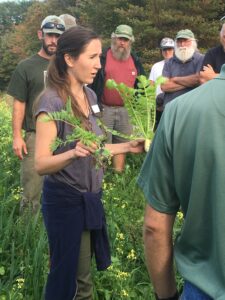Final report for ONE16-284C
Project Information
The overall goal for the New Hampshire Cover Crop Team’s activities is to encourage adoption through peer-to-peer interaction and support. We intend to recruit farms to partner with us for educational activities and on-farm demonstrations. From June 2016 through October of 2018, we held a series of eight field meetings and two forums for producers that demonstrated cover crop planting and management currently used by farms across the state in a variety of production systems. We also produced a series of six short videos that highlighted individual farms' cover cropping practices.
There were 85 farms and 20 ag service providers that particpated in these events, and the videos have had a combined 492 views within the first few months of being posted. Our evaluation gives further evidence that pee-to-peer learning is an effective way to provide information to farmers in a way that makes it easier for them to adopt new practices. Respondents to a survey of program participants indicated that the workshops, farmer forums, and field meetings the team delivered increased their knowledge in the benefits of cover crops, planting techniques, and cover cropping practices and species mixes appropriate for use in NH. We believe that our efforts have contributed to the increase in acreage under cover crops documented in NH: 1500 acres certified by NH-NRCS in 2013 vs. 4300 acres in 2018, with actual acreage (e.g. from farms not under NRCS contracts) exceeding that figure still.
The overall goal for the New Hampshire Cover Crop Team’s activities is to encourage adoption through peer-to-peer interaction and support. We intend to recruit farms to partner with us for educational activities and on-farm demonstrations. While we are primarily looking to highlight farms that use innovative cover crop species or planting practices, we also want to include a variety of production systems, including both field crops and horticultural crops; both conventional and organic management systems.
Proposed project activities include the following:
- We propose organizing two statewide Cover Crop Forums, in fall of 2016 and 2017. These events will be day-long, indoor programs where participants will have the opportunity to learn from their peers.
- Between fall 2016 and fall 2018, we will hold eight smaller scale field meetings in various locations around the state. These sessions will be held at the cooperating farms listed above and will highlight specific practices and techniques pertaining to the use of cover crops.
- On three sites where field meetings will be held in 2017 we will establish small field-scale (1-2 acre) plots with side-by-side comparisons to highlight issues of concern to farmers in the state and to demonstrate practices already known to be successful but that have not yet been widely adopted.
- We will produce a total of six short (approximately 5-10 minutes long) videos that cover the same innovative planting and management practices highlighted at the field meetings.
There has been a marked increase in the use of cover crops in recent years. Farmers with a wide variety of cropping systems, and at a range of scales, are increasingly using cover crops in ways that enable them to achieve soil conservation goals while maintaining or improving crop yields. According to the 2012 Census of Agriculture, 5025 acres were planted to cover crops; according to NH NRCS, farmers took advantage of aerial cover crop seeding programs to sow cover crops on some 3500 acres of cropland in 2015, more than triple the acreage of the previous year. However, this is still only a fraction of the more than 15,000 acres devoted to the production of field crops and vegetables statewide. There are still many opportunities for farmers to make better use of cover crops to reduce soil erosion and conserve nutrients.
There can be significant hurdles to integrating cover crops into rotations. For example, some benefits of cover crops only become apparent after several seasons, when improved soil structure, reduced erosion, and conserved nutrients and organic matter results in better crop yields. Some producers perceive the cost of seed and labor for establishing cover crops to exceed the benefits, or that their use comes at the expense of crop yields. Even producers who are more motivated to experiment with and make greater use of cover crops face challenges. Farms select species from dozens of options and employ new or unfamiliar planting practices, and they may need equipment that isn’t easily available to them. Making the wrong choice with anything from selecting the wrong species to improperly terminating a stand may yield poor results and discourage further experimentation.
We hope to continue the conversation that has begun about cover crops by highlighting examples where they have been used successfully. We will achieve this by providing opportunities for farmers to make direct observations in the field and to exchange dialogue with others who have found ways to make cover cropping work in this state.
Cooperators
Research
Accomplishments
2016
We held a meeting in June at Adrien Lavoie's farm in Hollis focusing on his use of cover crops and no-till in vegetable production. There were 40 people attending, including eight people from NRCS and Extension.
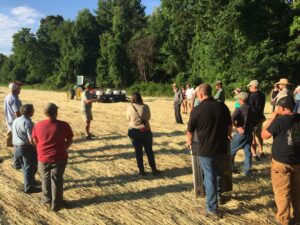
Twilight meeting at Lavoie Farm, June 2016
In November, we held a field meeting at Bohanan Farm, a dairy operation in Contoocook, to see results of plot demonstrating the use of a Penn State interseeder on field corn and to learn about the other ways the farm has been using cover crops. There were 26 participants, including six from NRCS and Conservation Districts. Participants saw the challenges involved with mid-season establishment of cover crops, and learned about methods for establishing them post-harvest.
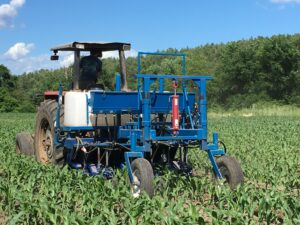
Interseeding field corn at Bohanan Farm, June 2016
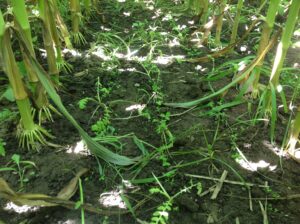
Field corn interseeded with a mix of annual ryegrass, red clover, and tillage radish at Bohanan Farm, August 2016
Our first Cover Crop Forum consisted of a tour of three dairy operations in Orford and N. Haverhill NH and Fairlee, VT that have experimented with cover crops, including use of a Penn State interseeder, living mulches, and a trial at the Grafton County Farm comparing mid-season and post-harvest establishment and different cover crop mixes. Following the tour, participants engaged in a facilitated discussion that touched on perceived benefits, establishment techniques, and species selection. The event was a collaboration between members of the team with the Grafton County Conservation District, UVM Extension, and NH-NRCS. There were 34 participants, including 5 from NRCS.
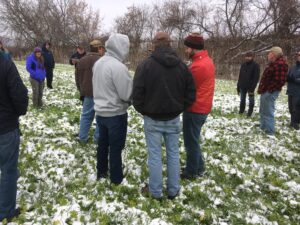
Cover crop tour, November 2016
2017
We held meetings at Highway View Farm in Boscawen, Tullando Farm in Orford, and Moulton Farm in Meredith. The first two meetings focused on field corn production, with Highway View Farm owner and team member Adam Crete demonstrating his use of no-till ‘planting green’ into cover crops. In addition, we were able to demonstrate one of the corn planters outfitted with Dawn Biologic roller-crimpers purchased by NH Association of Conservation Districts with funding from NRCS. The meeting at Tullando Farm in July demonstrated their experiments with using different species as ‘living mulches’ interseeded with corn, and also showcased the Dawn Biologic planters.
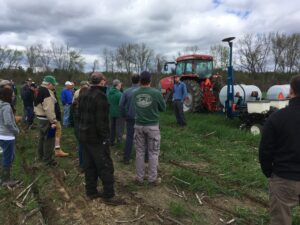
Adam Crete discussing use of cover crops and no-till planting techniques, May 2017
Olivia Saunders discussing cover crop mixes at Moulton Farm field meeting, October 2017
The NRCS Soil Health Initiative had some money available in the state, and the NH Soil Health Partnership (NHSHP) – representing NH-NRCS, state Conservation Districts, UNH Extension, and private industry – developed several cover crop seed mixes designed for different cropping systems and conditions across the state. The NH Cover Crops Team (which includes two members working with the Soil Health Group) helped to recruit farms to evaluate these mixes. To date there are some 21 farms participating. One of these, Moulton Farm in Meredith, served as the site for our third field meeting; attendees were able to observe how well the seed mix grew, and the differences in biomass with seeding date.
We held our second Cover Crop Forum on Nov 29 in Concord. The program was split between presentations from UNH faculty, NRCS, and area farmers in the morning, and a farmer-to-farmer discussion facilitated by Dr. Eric Sideman of Maine Organic Farmers and Gardeners Association (MOFGA) in the afternoon. There were a total of 31 participants, including 6 from NRCS. Morning presentations focused on integrating cover crops with vegetable rotations for organic operations, an update on the cover crop mixes developed by NHSHWG, and farmer adoption of cover cropping techniques. Discussion in the afternoon centered on topics identified by participants, including species selection, integrating with cash crops, and special pest management considerations.
2018
We held three field meetings at Heron Pond Farm in South Hampton in April, and at Longview Farm in Plymouth and McNamara Dairy in Plainfield in October. All three events showcased the producers’ cover cropping practices: integrating with crop planting and harvesting, species selection, and planting techniques. All three farms were also participants in the NHSHP seed mix evaluation, so participants were able to observe how readily they established, how sensitive they were to planting date, and how well they overwintered. There were a total of 65 participants between these three events, ten of whom were ag service providers from various agencies (NRCS, Conservation Districts, UVM Extension and UNH Extension)

Reviewing seed mixes at McNamara Dairy field meeting, October 2018
Initial observations indicate that the mixes developed by NHSHP have established successfully. Much of fall in 2017 was characterized by milder-than-normal weather that was conducive to plant growth, such that fields had close to 70% cover (as measured by the Canopeo app) around 30 days after sowing - even in fields sown as late as the first week of October. By contrast, an excessively wet fall in 2018 delayed harvesting and sowing, but ground cover varied by location from 27-47% by the 30-day mark.
These trials provide evidence that multi-species cover crop mixes are feasible for both vegetable and field crop production systems. Despite an extended cold snap from late December 2017 until mid-January 2018, the stands seemed to have survived the winter with up to 45% cover, with even crimson clover – considered marginally winter-hardy in NH – showing some regrowth in spring. Out of 27 farms that participated in the trial over the last two years, five have purchased these mixes to use on their own. NHSHP is continuing to evaluate the mixes going into the spring of 2019, and may modify them to further improve performance.

Farm participating in the cover crop demonstrations were featured on a cover crop tour at the 2017 New Hampshire Association of Conservation Districts (NHACD) Working Lands Conference (photo by Jess Gerrior)
Education & outreach activities and participation summary
Participation summary:
The NH Cover Crop Team produced a series of six short videos highlighting specific cover cropping practices for a variety of farms located across the state:
Planting Green demonstrates the use of cover crops in combination with no-till planting for field corn
Record Keeping shows one farms method for keeping track of planting dates, mixes, and the results for new species or mixes they're experimenting with
Benefits and Experiments documents one farm discussing the importance of using cover crops and the benefits he sees them providing, and describing his experiments with new cover crop mixes and species
Heron Pond Farm and Moulton Farm interview farm owners and managers, where they describe their cover cropping practices in detail.
The last of the series is a Time-Lapse video comparing the growth of the 'Early Veggie N-Boost' mix developed by NHSHP from fall into early winter at locations across the state.
In addition to the work outlined in the original proposal, the NH Cover Crop Team launched a new program in fall 2017 to recognize farms that were making effective use of cover crops and to encourage additional farms to follow suit. The We’ve Got it Covered! campaign provides signs that farms can display in their fields, highlighting their use of cover crops and increasing public awareness of their benefit to the environment. The effort was funded by donations from Johnny’s Selected Seeds and the NH Vegetable and Berry Growers’ Association, plus an AgEnhancement grant from Farm Credit East, enabling us to have 250 signs printed for distribution around the state. Any farm that planted cover crops was eligible to get a sign free of charge, and participating farms were encouraged to share photos on social media using the #nhcovercrops hashtag.
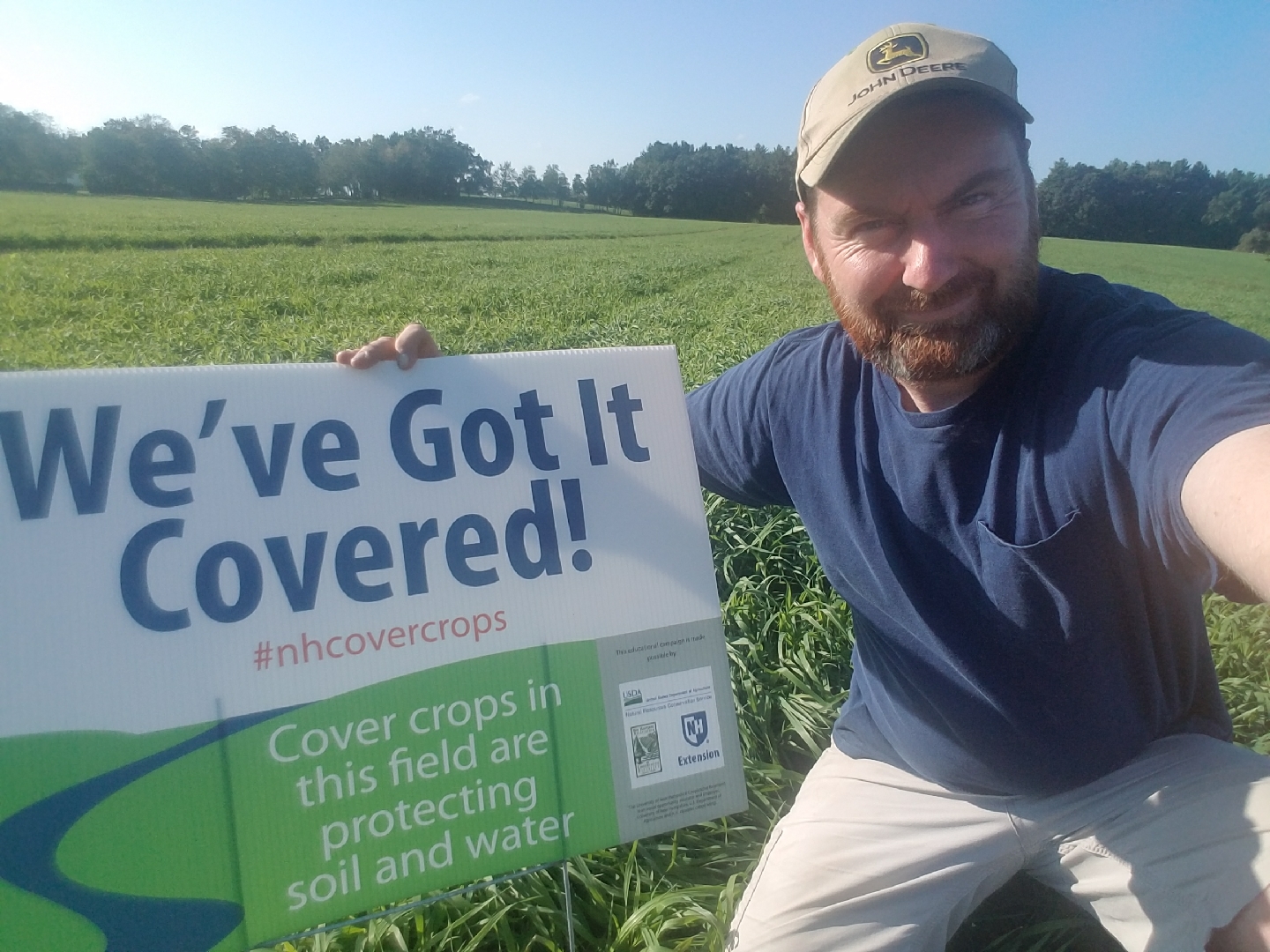
Learning Outcomes
The NH Cover Crop Team sent out a survey to people participating in their programs from 2016-2018. Four farms responded, two of them cropping more than 200 acres. Respondents indicated that the workshops, farmer forums, and field meetings the team delivered increased their knowledge in the benefits of cover crops, planting techniques, and cover cropping practices and species mixes appropriate for use in NH. Ag service providers attending these programs indicated that they intend to share what they’ve learned with their clients.
Three of the four farms responding indicated that an average of 40% of their land was sown to cover crops five years ago, but that they all intend to sow 90-100% of their land this coming fall. One farmer commented: “I’d say that I’ve learned more about the diversity of cover crop species available for NH growers. I’m very interested to see these mixes refined and seeding dates and rates nailed down”
These responses align with other data regarding the use of cover crops. According to USDA-NRCS, cover crop usage increased from 1527 acres in 2013 to 4358 acres in 2018. Interviews with farms and anecdotal evidence indicates that the total acreage is higher across the state; several farms have seen enough benefits from sowing cover crops that they have continued to do so without NRCS cost-sharing. We conservatively estimate that over half of the corn acreage in the state –more than 6,000 acres – is now sown to cover crops. While the NH Cover Crop Team cannot claim full credit for this, producers have cited the Team’s work in increasing their awareness of new developments in the use of cover crops. One attendee writes: “At [an October field meeting] I was impressed with the work on the two mixes that you came up with. Although the upstate returns won’t be in until spring, I was impressed with germination and growth for the time frame in the ground, and how a multitude of soil benefits were looked at in designing the mix. As we lessen our embrace on the peas/oat or rye/vetch covers, familiarity with the different species and what they do will be very important information”
Project Outcomes
Responses to surveys and conversations with individual farms indicate that the NH Cover Crop Team's efforts have resulted in producers having an increased awareness and better understanding of both the benefits of cover crops and effective methods for establishing them. Accordingly, these efforts have contributed to the increase in acreage in cover crops documented in the state over the last five years.
In partnering with NHSHP, there have been over 30 farms that have either participated in cover crop mix evaluation trials or who have expressed an interest in doing so for the upcoming growing season. So far, there have been five farms (with a total of approximately 650 acres) that have gone on to use these mixes on their operations
The results that we've documented confirm that approaches that encourage peer-to-peer learning among farmers is effective. Both in field meetings and in in forums, farmer participants were engaged in conversations and more receptive to the information presented.
Members of the NH Cover Crop Team intend to continue programming in this area moving forward, and we intend to continue focusing on peer-to-peer learning. As a sort of coalition that includes NRCS, Conservation Districts, and Extension NHSHP is coordinating outreach efforts to further promote cover crop adoption, and they're developing plans for more field meetings in the 2019 growing season.
Initial evaluations indicate that the cover crop mixes NHSHP can provide effective soil cover. We are planning for more detailed evaluations starting in spring 2019, with more extensive biomass measurements and some species separation to assess how the proportions of species present might change between emergence and termination the following spring.
